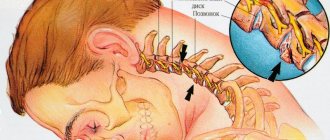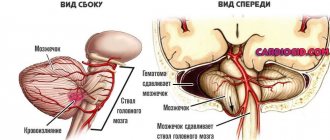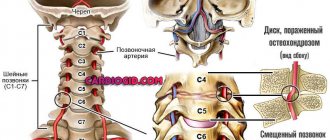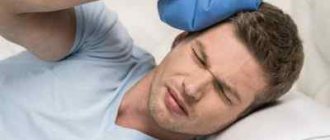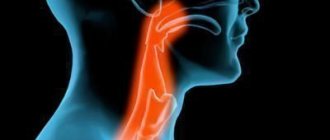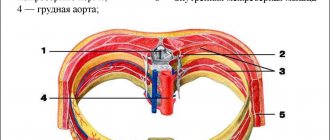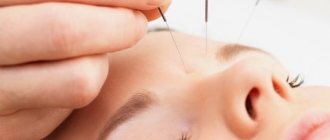Treatment of diseases through surgery is stressful for the whole body. The operation is performed under anesthesia, which often causes a number of side effects.
In some cases, a headache begins to ache after anesthesia (narcosis). It happens that this alarming sign is not paid attention to, patiently waiting for everything to go away on its own.
This symptom should not be treated with disdain - after anesthesia, a headache can occur for several reasons, each of which requires urgent action. What factors cause headaches, what remedies will cope with the side effect, in what cases should you sound the alarm and immediately go to the doctor?
Types of pain relief
Before the operation, the anesthesiologist, taking into account all the characteristics of the body and past diseases, selects the type of anesthesia. There are several types of pain relief:
- Epidural anesthesia. This is the introduction of an anesthetic fluid into the epidural space of the spine without damaging the dura mater of the spinal cord. The occurrence of headaches after anesthesia is excluded. Spinal anesthesia is used, for example, during childbirth.
- General anesthesia. A complete loss of consciousness occurs; if necessary, a special tube is inserted into the trachea for breathing. There is no pain or discomfort at all.
- Spinal anesthesia. The use of spinal anesthesia is recommended if necessary to numb the lower part of the body (lower limbs, pelvic organs). The needle is inserted into the lumbar region, through the hard shell of the spinal cord, and part of the cerebrospinal fluid is removed. The injection is made into the subarachnoid space.
With any type of anesthesia, much depends on the professionalism of the anesthesiologist - preparation for the operation should be carried out by an experienced doctor.
Advantages and disadvantages
Like many methods that are aimed at getting rid of pain, the procedure has its advantages and disadvantages.
If we talk about the advantages of epidural therapy, then the main thing can be considered that when the method is used during childbirth, the woman remains fully conscious. If we compare this anesthesia with other procedures, then unlike other anesthesia (for example, endotracheal anesthesia), the organs remain intact and are not exposed to harmful substances. After anesthesia, patients do not experience a sharp drop in pressure, hemodynamic parameters remain normal, and no sudden disturbances are noticed.
When epidural anesthesia is used during childbirth, the woman does not have to worry about the condition of the child when administering substances - this does not affect the newborn in any way.
As for the disadvantages of this procedure, there are also quite a lot of them. For example, when anesthesia is used, the connection between the child and the mother is disrupted and the hormones that the child needs at this time are no longer produced.
Often after epidural anesthesia, patients experience severe headaches, this is due to the flow of cerebrospinal fluid into the epidural space. When a large amount of anesthetic is administered, pain may occur or some bodily function may be impaired.
Another disadvantage of this method is that after its use, subarachnoid hemorrhage and various allergic reactions may occur.
Side effects of anesthesia
Patients often complain that after anesthesia a headache begins. Women who have given birth also complain of pain after epidural anesthesia during caesarean section. In addition to headaches, other symptoms are also troubling, each of which requires special treatment.
Of all the body's reactions to anesthesia, patients are most often bothered by the following symptoms:
- pain in the area where the needle was inserted;
- prolonged nausea accompanied by dry mouth (vomiting occurs rarely);
- regular dizziness (occasionally ending in fainting);
- decreased blood pressure;
- the neck loses mobility and hurts (especially after spinal anesthesia);
- rare pulse;
- weakness, fatigue, decreased physical activity;
- discomfort (itching, burning) in the spine;
- the appearance of red spots on the head under the hair;
- decreased sensitivity of the lower extremities.
For 2-4 hours, the anesthesiologist monitors the patient’s general condition. If side effects appear 1-2 days after surgery, be sure to inform your doctor about the body’s alarm signals.
Causes of headache after pain relief
Injections into the back area always bring pain and discomfort to the patient. The manipulations are carried out by an anesthesiologist in the operating room. Why does my head hurt after using anesthesia? Headache immediately after spinal anesthesia can occur in the following cases:
- removal of a large amount of fluid, which leads to a sharp decrease in intracranial pressure;
- exceeding the recommended amount of painkiller, which causes a sharp rise in pressure inside the skull;
- problems with the spine (osteochondrosis, previous injuries, scoliosis);
- the patient’s anxiety during the operation, which is accompanied by sudden turns of the head - this causes pressure surges;
- the use of a thick needle - cerebrospinal fluid leaks through the hole;
- congenital pathologies of the spinal cord;
- dehydration of the body.
The effects of anesthesia usually appear 1-4 hours after the anesthetics wear off. The anesthesiologist should immediately tell you about the possible side effects of anesthesia, one of which is prolonged pain in the head. If you experience cephalalgia after general anesthesia, you should consult a doctor who will determine the cause of the symptom and prescribe the necessary treatment.
Using saline solution
In some cases, instead of blood, saline is injected into the same subarachnoid area. The procedure is recommended to be carried out on the same day on which the intervention in the spinal region was performed, be it a puncture, epidural anesthesia or other procedures.
The manipulation can be carried out for more than 24 hours. In this case, the amount of saline solution administered is from one to one and a half liters.
The method has both some advantages and disadvantages. The advantage is that the procedure significantly reduces the risk of infection, since the solution is sterile, and the effect is guaranteed to be almost the same as when using an epidural patch.
But the downside is that the solution has a rather liquid consistency and is therefore absorbed very quickly. For this reason, with its support, the pressure cannot be adjusted as effectively and quickly as when applying a blood patch.
How to relieve headaches after surgery
If you have a headache after anesthesia, treatment options can only be determined by a qualified doctor. If spinal anesthesia was used, it is recommended to spend the first postoperative hours lying down, without a pillow. You should not turn your head, try to get up, or even stand up unless your doctor gives permission.
On the first day after surgery, it is recommended to strictly follow the doctor’s instructions. It is not advisable to walk or even sit; you are only allowed to roll over, move your limbs, and carefully turn your head.
Treatment of headaches that appear as a result of anesthesia is carried out using several methods. The use of medications, the introduction of saline, an epidural patch - only the doctor decides what will most effectively cope with the complications of surgery. Each method has its own characteristics, limitations, and side reactions.
Medicines
Headaches that occur after epidural anesthesia are not uncommon, so you should not tolerate them; it is better to inform your doctor about the unpleasant sensations immediately. Most often, pharmaceutical drugs are used for complications.
Medications for headaches are prescribed:
- Narcotic painkillers. A single use of drugs that can cause addiction is recommended. The analgesic effect lasts up to 10 hours.
- Anti-inflammatory non-steroidal drugs. They relieve headaches that appear after the administration of anesthesia, and remove swelling at the injection site.
- Painkillers that do not have a narcotic effect. They are administered intramuscularly, pain does not bother you for up to 5-8 hours.
- Antiemetic drugs. The use of these drugs is recommended only for general malaise and severe attacks of nausea.
- Plasma substitutes. They are used for a sharp drop in blood pressure and prolonged headaches.
Medicines are selected individually, taking into account all the characteristics of the body. Doctors often resort to complex treatment - the use of several groups of drugs.
Epidural patches
If severe headaches occur immediately after spinal anesthesia, treatment is carried out using a blood patch. The essence of the technique: blood is drawn from a vein passing in the bend of the elbow, which is injected into the area of the previous injection.
After a few minutes the blood begins to clot. The clot that forms fills the hole in the dura mater of the spinal cord that was left after the painkiller was administered. The blood clot stops the leakage of cerebrospinal fluid. The blood patch helps normalize intracranial pressure, after which the headache goes away completely.
Introduction of saline solution
The use of a blood patch is unsafe for the patient’s health and has many contraindications. If you have a headache after using epidural anesthesia, the injection of saline solution is considered a more gentle method of treatment. The effect is not much different from blocking a hole in the dura mater of the spinal cord with a blood clot - headaches completely disappear. The advantage of administering saline is that the risk of infection is reduced.
There is one significant drawback to using saline solution. Its density is significantly lower than that of blood. Therefore, the pressure does not return to normal as quickly as after the patch.
Massage
Massage, which should only be performed by a specialist in the first days after surgery, will help relieve headaches after anesthesia. Massaging movements relieve discomfort, relieve pain, restore blood supply to the tissues of the head, and normalize metabolic processes.
To get rid of the feeling of discomfort, it is recommended to massage the painful area of the head with stroking movements. The duration of the manipulations is no more than a quarter of an hour. No more than 2-3 procedures can be performed per day.
Folk remedies
The use of alternative medicine for headaches after anesthesia is an effective method of treatment. The only rule: consult your doctor first. If there are no contraindications, the doctor will certainly allow the use of home remedies.
If you experience headaches after anesthesia, it is recommended to drink mint tea.
Preparation:
- Grind mint leaves (15 g).
- Brew the herbal pulp with boiling water (200 ml).
- Leave for 3 hours, strain.
Drink only before bedtime. Dosage – 100 ml. The aromatic liquid relieves pain, swelling, and relieves attacks of nausea.
Juices from currants, blueberries, and viburnum have an effective effect against headaches. It is recommended to take them 120 ml three times a day. Be sure to prepare only fresh juice. The high content of vitamins in the drink can improve the functioning of the nervous system, normalize blood pressure, and relieve pain.
Hot baths for the lower extremities are a proven way to cope with headaches. It is enough to keep your feet in warm liquid for at least a quarter of an hour to say goodbye to complications that arise after anesthesia for a long time.
Headache after epidural anesthesia
My hypnobirthing
